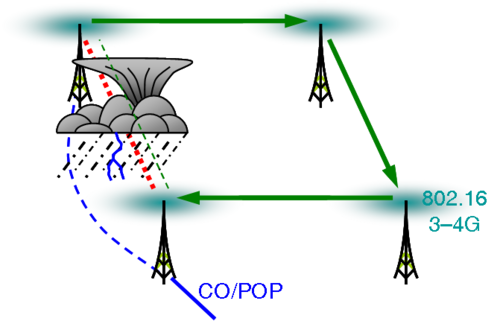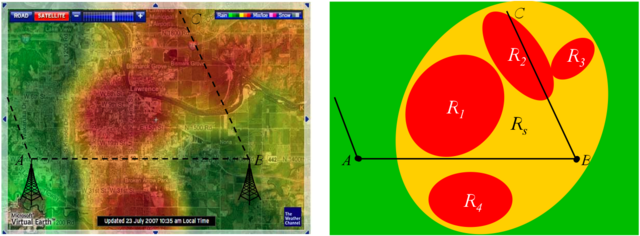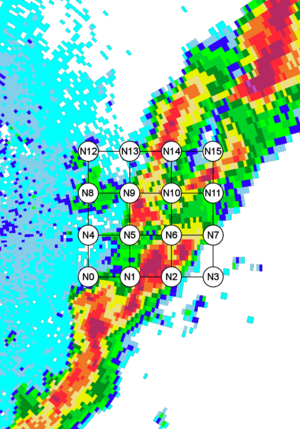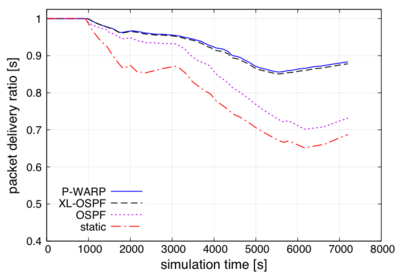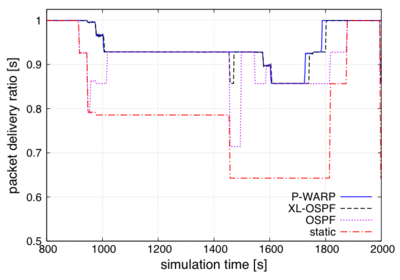Weather Disruption-Tolerant Mesh Networking
There has been increased interest in the deployment of high-bandwidth point-to-point fixed wireless links as an alternative to fiber optic links due to cost or regulatory concerns. Applications include extending broadband Internet access, backhaul for 3G and proposed 4G deployments, and front-haul umbilical facilities for distributed antenna systems (DAS). Millimeter wave (70-90 GHz) wireless link technology is emerging for very short distances, but has the potential to span several miles and deliver data rates of 1–10 Gb/s. Unfortunately, these frequencies suffer significant attenuation due to atmospheric phenomena such as rain. This project is deploying test links, characterising their performance during real weather events such as thunderstorm, and applying predictive routing techniques to a mesh network to mask impairments.
Contents |
Project activities
Link Characterisation
The primary factor attributing to disruptions in millimeter-wave transmission is rain attenuation. This attenuation is caused by two aspects of rain in the transmission path: scattering by droplets and absorption of water. We are conducting measurements on test links to measure and quantify weather disruptions on millimeter wave deployments. So far we have collected data to correlate precipitation and humidity to bit error rates on test links. Experimental results will be compared with existing models such as Crane models and the ITU-R P.530 recommendation that employ probabilistic and empirical methods to calculate the attenuation for a given probability distribution of the rain rate. The objective is to derive a realistic calculation of link attenuation per km for rain distributions typical of midwest US.
Storm Modelling
The link characterization step (above) provides a link error model for a give rate rate. However, for a mesh network, we are interested in finding the effect of a rain storm on the overall topology. Moreover, disruption tolerance demands a methodology that can adapt the network to the challenge in real time. Therefore, we are developing storm models based on radar echos so that network disruptions can be calculated from real-time weather imagery and very-short-term predctions.
We propose a simple geometric model in which each region in a radar reflectivity map is modelled as an ellipse. While the resolution of the radar reflectivity differentiates several levels of precipitation, the proposed model uses only three levels indicating high (red), low (yellow) and little or no (green) precipitation so that the method remains tractable. Each region is represented as an ellipse (R1–R5) in the geometric model. Note that there could be several regions of the same rain intensity in a given storm. Finally, individual links are modeled as line segments. The attenuation caused on the link due to a single region is then calculated based on the length of link that is affected and the rain rate of the region. The total attenuation on a given link is the summation of the attenuation resulting from all the individual regions that intersect or encompass the line segment.
Realistic Storm Patterns
In order to determine the impact of actual rain storms, we collected radar reflectivity data from the National Weather Service for the Midwest US. The effect of a weather disruption on a millimeter-wave network mainly depends on two factors: rain rate and the geographic footprint of the storm. Both of these parameters vary from one geographic region to another. Based on the weather data for southern great plains of US, we can draw two conclusions: First, the majority of the storms are small enough for a metropolitan size mesh network (approx. 1000 km2) to reroute traffic around the storm. Secondly, even moderate sized storms are likely to have small size heavy intensity regions since they don't account for a significant percentage of rainfall. For example, the adjacent figure shows an instance of an actual storm observed on 30 September 30 2008 20:39:26 UTC near a 30×30 km grid located at 38.8621N, 95.3793W. It clearly shows that the feasibility of routing around failed links N13–N14, N11–N15, N2–N6, and N1–N2 at this time instant.
Predictive Mesh Routing
One of most common operational scenario for millimeter wave mesh networks is data hauling across a metropolitan area network to an Internet service gateway. Hence, the objective of the routing protocol is to route data from all the nodes in the grid to one or more gateway nodes. Mesh networks are well suited to this application since there is more than one (an in many cases several) path available between a source destination pair. We are investigating routing algorithms that can effectively route data around link failures. Since the primary disruption in this scenario is that of physical link, cross-layer mechanisms that exploit any available physical layer information in making routing decisions are expected to perform better.
We are currently investigating both reactive and predictive methods with the objective of finding the most efficient protocol that meets the service specification of a host of potential application. In particular, we propose two novel routing protocols:
Cross-Layered OSPF (XL-OSPF): A reactive method based on modified OSPF protocol that utilizes link BER in routing calculations The basic idea here is to use a cost metric that is proportional to the bit error rate of the link. Even with the error based cost metrics, OSPF remains a reactive protocol that requires a finite amount of time before it adapts to changes in link state. If the application or service demands a highly-reliable service, reactive protocols must have a very short update interval on the order of milliseconds.This adds an unacceptable level of overhead, even for broadband networks.
Predivtive Weather Assisted Routing Protocol (P-WARP): A predictive method that utilizes weather forecast to predict the link status of each link in the network and routes to minimize the service disruptions. This is a link-state based algorithm that utilizes weather radar reflectivity data modeled in real-time as discussed above to calculate the BER of each link. This processing is done at gateway node(s), which then propagate link status updates throughout the network. Because of its predictive nature, P-WARP has two distinct advantages: first, it has no reaction time that might be necessary if stringent service requirements (such as 50 msec restoration time frequently advertised by network service providers) are to be met; second, the frequency of weather updates does not scale with the restoration times leading to lower protocol overhead.
The adjacent figure shows the packet delivery ratio of a mesh network during an actual storm observed over the Midwest US. The cumulative average shows that the P-WARP outperforms all other protocol with XL-OSPF following closely. The windowed average of the packet delivery ratio shows the transient affects of storm on various routing protocols. While static and stock OSPF take a long time to recover from storm distrubance starting at t = 960 sec, both XL-OSPF and P-WARP show minimal degradation. Of particular importance is the zero reaction time of P-WARP which continues to deliver maximum packets before and after the event occurrence.
Related Projects
Presentations and Publications
Papers
Abdul Jabbar, Bharatwajan Raman, Victor S. Frost, and James P.G. Sterbenz,
“Weather Disruption-Tolerant Self-Optimising Millimeter Mesh Networks”,
Third International IFIP/IEEE Workshop on Self-Organizing Systems (IWSOS 2008),
Vienna, December 2008,
LNCS 5343, Springer, Heidelberg, pp. 242–255.
BibTex
- Keywords: Resilient, survivable, weather disruption tolerant, millimeter-wave, mesh network, predictive routing, self-optimising, self-optimizing.
- Abstract: Millimeter-wave networks have the potential to supplement fiber in providing high-speed Internet access, as well as backhaul for emerging mobile 3G and 4G services. However, due to the high frequency of operation (70–90 GHz), such networks are highly susceptible to attenuation from rain. In this paper, we present several mechanisms to overcome the disruptive effects of rain storms on network connectivity and service reliability. A resilient mesh topology with cross-layering between the physical and network layer has the capability to self-optimise under the presence of unstable links. We present a novel domain-specific predictive routing algorithm P-WARP that uses real-time radar data to dynamically route traffic around link failures as well as a modified link-state algorithm XL-OSPF that uses cross-layering to achieve resilient routing. Simulations are conducted to evaluate the effectiveness of the proposed algorithms.
Abdul Jabbar, Justin P. Rohrer, Andrew Oberthaler, Egemen K. Çetinkaya, Victor S. Frost, and James P.G. Sterbenz,
“Performance Comparison of Weather Disruption-Tolerant Cross-Layer Routing Algorithms”,
Proceedings of 28th IEEE Conference on Computer Communications (INFOCOM 2009),
Rio de Janeiro, April 2009, pp. 1143-1151.
BibTex
- Keywords: Resilient, survivable, weather disruption tolerant, millimeter-wave, mesh network, P-WARP predictive routing, XL-OSPF, performance analysis, cross-layer optimisation optimization.
- Abstract: With growing demand for high-speed access to mobile handheld devices, there is a significant cost benefit in deploying fixed wireless-mesh networks for backhaul access. However, enabling reliable broadband access over high-frequency radios (such as millimeter-wave networks) posses a fundamental challenge due to weather disruptions in general and rain attenuation in particular. In this paper, we present an analysis of the impact of precipitation on millimeter-wave mesh networks based on radar measurements of real storms in the Midwest US. Secondly, we compare two novel algorithms that use physical layer information to optimize routing at the network layer: P-WARP (Predictive Weather Assisted Routing Protocol) and XL-OSPF (Cross-Layered Open Short Path First). Finally, we present simulation studies to compare the performance of the proposed protocols and evaluate the dependability of the end-user service during weather disruptions.
Donna F. Tucker, Dallas W. Smith, Daniel DePardo, Timothy Euler, Peter Youngberg,
“Effect of Atmospheric Hydrometers on Millimeter Wave Transmissions”,
12th Conference on Integrated Observing and Assimilation Systems for the Atmospheres – Oceans and Land Surface,
American Meterological Society, New Orleans, 20–24 January 2008, paper 2.4
Posters
Abdul Jabbar, Vinay Muralidharan, Andrew Oberthaler, Bharatwajan Raman, Victor S. Frost, and James P.G. Sterbenz,
Weather Disruption-Tolerant Millimeter-Wave Mesh Networking,
ITTC IAB poster, The University of Kansas, June 2008.
Abdul Jabbar, Vinay Muralidharan, Bharatwajan Raman, Victor S. Frost, and James P.G. Sterbenz,
Weather Disruption Tolerant Wireless Gigabit Mesh Architecture,
KU Engineering GPA poster, The University of Kansas, June 2008.
Vinay Muralidharan, Bharatwajan Raman, Dallas Smith, Gary J. Minden, James P.G. Sterbenz, Donna Tucker, Alexander M. Wyglinski, and Victor S. Frost,
Robust Millimeter Wave Metropolitan Communication Links,
ITTC IAB poster, The University of Kansas, June 2007.
Abdul Jabbar, Vinay Muralidharan, Bharatwajan Raman, Alexander M. Wyglinski, Victor S. Frost, and James P.G. Sterbenz,
Weather Disruption-Tolerant Wireless Mesh Architecture ,
ITTC IAB poster, The University of Kansas, June 2007.
Presentations
James P.G. Sterbenz, Abdul Jabbar, Justin P. Rohrer, Egemen Çetinkaya, Bharatwajan Raman, and Victor S. Frost
“Weather Disruption-Tolerant Self-Optimising Millimeter Mesh Networks: Architecture, Routing Protocols, Performance”,
April 2009
James P.G. Sterbenz, Victor S. Frost, Alexander M. Wyglinski, Abdul Jabbar, Vinay Muralidharan, and Bharatwajan Raman,
“Disruption-Tolerant Millimeter Wave Wireless Mesh: Architecture and Research” (presentation),
Toward Use of GigaBit Millimeterwave Wireless in Cellular and Enterprise Networks,
IWPC (International Wireless Industry Consortium) Workshop, Dulles VA, June 2007
People
Graduate Research Assistants
Abdul Jabbar*: technical lead for routing algorithms and mesh simulations
Justin P. Rohrer*: mesh and predictive routing simulations
Egemen Çetinkaya*: mesh and predictive routing simulations
Vinay Muralidharan2: link characterisation
Bharatwajan Raman2: link modelling
Undergraduate Student Assistants
Jacob Foiles3
Andrew Oberthaler3
Dallas Smith3
Research Staff
Daniel DePardo
Adam Hock3
Principal Investigators
James P.G. Sterbenz* (co-PI): disruption-tolerant mesh networking and predictive routing
Donna F. Tucker* (co-PI): meteorology
Alex Wyglinski1 (co-I): communication link charactarisation
Victor S. Frost* (PI): communication link charactarisation
*The University of Kansas – 1,2,3work performed while at KU, current affiliations: 1Worcester Polytechnic Institute, 2
Sponsors
This work funded in part by Sprint Nextel
This work funded in part by NSF FIND program
